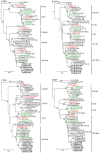Phylogenetic and molecular characterization of H9N2 influenza isolates from chickens in Northern China from 2007-2009
- PMID: 20927364
- PMCID: PMC2947496
- DOI: 10.1371/journal.pone.0013063
Phylogenetic and molecular characterization of H9N2 influenza isolates from chickens in Northern China from 2007-2009
Abstract
The repeated transmission to pigs and humans, and the long-term endemicity in terrestrial poultry of H9N2 viruses in China lend urgency to the study of their ecology and pathogenicity. In the present paper, we reported an H9N2 virus sublineage isolated from chickens in northern China from 2007 to 2009 has high lethality for mice. Phylogenetic analysis of the full genome indicated that six representative H9N2 isolates shared high homology to each other, and they clustered in the same sublineage with other H9N2 viruses isolated recently in northern China. The isolates were double-reassortant viruses containing M genes similar to A/Quail/Hong Kong/G1/97 (H9N2) and the other seven gene segments from A/Chicken/Shanghai/F/98 (H9N2). These six isolates were capable of replicating in the lungs of infected chickens without producing observable clinical signs of disease or death. However, they were highly lethal to mice with mortality rates as high as 100% (14/14) without prior adaptation. The affected mice exhibited severe respiratory syndromes and diffuse lung injury. The H9N2 viruses could be detected in multiple organs of the infected mice, including hearts, livers, spleens, lungs and kidneys. Our findings demonstrated that H9N2 viruses isolated from the chickens in northern China have established a stable sublineage with enhanced pathogenicity to mice, suggesting that urgent attention will need to be paid to the transmission of H9N2 viruses from chickens to mammals.
Conflict of interest statement
Figures





References
-
- Kawaoka Y, Chambers TM, Sladen WL, Webster RG. Is the gene pool of influenza viruses in shorebirds and gulls different from that in wild ducks? Virology. 1988;163:247–250. - PubMed
-
- Homme PJ, Easterday BC. Avian influenza virus infections: I. Characteristics of influenza A-turkey-Wisconsin-1966 virus. Avian Dis. 1970;14:66–74. - PubMed
-
- Alexander DJ. A review of avian influenza in different bird species. Vet Microbiol. 2000;74:3–13. - PubMed
-
- Shortridge KF. Pandemic influenza: A zoonosis? Semin Respir Infect. 1992;7:11–25. - PubMed
Publication types
MeSH terms
LinkOut - more resources
Full Text Sources

